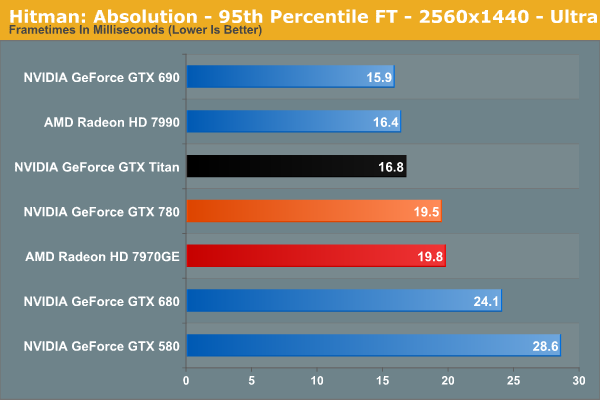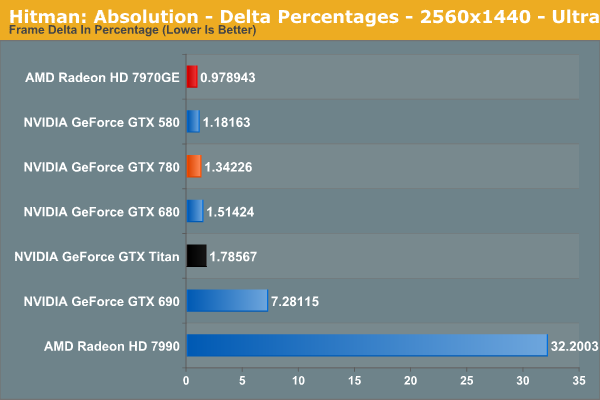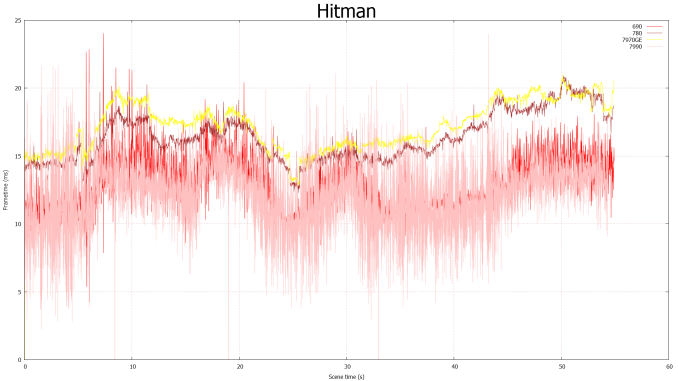NVIDIA GeForce GTX 780 Review: The New High End
by Ryan Smith on May 23, 2013 9:00 AM ESTOur First FCAT & The Test
First announced back at the end of March, FCAT has been something of a bewildering experience for us. NVIDIA has actually done a great job on the software, but between picky games, flaky DVI cables, and dead SSDs (we killed an Intel enterprise grade SSD 910 with FCAT) things have not gone quite to plan, pushing back our intended use of FCAT more than once. In any case, with most of the kinks worked out we’re ready to start integrating it into our major GPU reviews.
For the time being we’re putting FCAT on beta status, as we intend to try out a few different methods of presenting data to find something that’s meaningful, useful, and legible. To that end we’d love to get your feedback in our comments section so that we can further iterate on our presentation and data collection.
We’ve decided to go with two metrics for our first run with FCAT. The first metric is rather simple: 95th percentile frametimes. For years we’ve done minimum framerates (when practical), which are similar in concept, so this allows us to collect similar stats at the end of the rendering pipeline while hopefully avoiding some of the quirkiness that comes from looking at minimum framerates within games themselves. The 95th percentile frametime is quite simply the amount of time it takes to render the slowest 5% of frames. If a game or video card is introducing significant one-off stuttering by taking too long to render some frames, this will show us.

This is primarily meant to capture single-GPU issues, but in practice with AMD having fixed the bulk of their single-GPU issues months ago, we don’t actually expect much. None the less it’s a good way of showing that nothing interesting is happening in those situations.
Our second metric is primarily focused on multi-GPU setups, and is an attempt to quantize the wild frametime variations seen at times with multi-GPU setups, which show up as telltale zigzag lines in frametime graphs.
In this metric, which for the moment we’re calling Delta Percentages, we’re collecting the deltas (differences) between frametimes, averaging that out, and then running the delta average against the average frametime of the entire run. The end result of this process is that we can measure whether sequential frames are rendering in roughly the same amount of time, while controlling for performance differences by looking at the data relative to the average frametime (rather than as absolute time).

In general, a properly behaving single-GPU card should have a delta average of under 3%, with the specific value depending in part on how variable the workload is throughout any given game benchmark. 3% may sound small, but since we’re talking about an average it means it’s weighed against the entire run. The higher the percentage the more unevenly frames are arriving, and exceeding 3% is about where we expect players with good eyes to start noticing a difference. Alternatively in a perfectly frame metered situation, such as v-sync enabled with a setup that can always hit 60fps, then this would be a flat 0%, representing the pinnacle of smoothness.
Moving on, we’ll be running FCAT against 6 of our 10 games for the time being: Sleeping Dogs, Hitman: Absolution, Total War: Shogun 2, Battlefield 3, Bioshock, and Crysis 3. The rest of our games are either highly inconsistent or generally fussy, introducing too much variance into our FCAT results.
Finally, due to the amount of additional time it takes to put together FCAT results, we’re going to primarily publish FCAT results with major product launches and major driver updates. Due to how frame metering works, the only time frame consistency significantly changes is either with the introduction of new architectures/GPUs, or with the introduction of significant driver changes, so those are the scenarios we’ll be focusing on.
The Test
NVIDIA’s launch drivers for the GTX 780 are 320.18, drivers that are essentially identical to the public 320.14 drivers released last week.
| CPU: | Intel Core i7-3960X @ 4.3GHz |
| Motherboard: | EVGA X79 SLI |
| Power Supply: | Antec True Power Quattro 1200 |
| Hard Disk: | Samsung 470 (256GB) |
| Memory: | G.Skill Ripjaws DDR3-1867 4 x 4GB (8-10-9-26) |
| Case: | Thermaltake Spedo Advance |
| Monitor: | Samsung 305T |
| Video Cards: |
AMD Radeon HD 7970 GHz Edition AMD Radeon HD 7990 NVIDIA GeForce GTX 580 NVIDIA GeForce GTX 680 NVIDIA GeForce GTX 690 NVIDIA GeForce GTX 780 NVIDIA GeForce GTX Titan |
| Video Drivers: |
NVIDIA ForceWare 320.14 NVIDIA ForceWare 320.18 AMD Catalyst 13.5 Beta 2 |
| OS: | Windows 8 Pro |











155 Comments
View All Comments
milkman001 - Friday, May 24, 2013 - link
FYI,On the "Total War: Shogun 2" page, you have the 2650x1440 graph posted twice.
JDG1980 - Saturday, May 25, 2013 - link
I don't think that the release of this card itself is problematic for Titan owners - everyone knows that GPU vendors start at the top and work their way down with new silicon, so this shouldn't have come as much of a surprise.What I do find problematic is their refusal to push out BIOS-based fan controller improvements to Titan owners. *That* comes off as a slap in the face. Someone spends $1000 on a new video card, they deserve top-notch service and updates.
inighthawki - Saturday, May 25, 2013 - link
The typically swapchain format is something like R8G8B8A8 and the alpha channel is typically ignored (value of 0xFF typically written), since it is of no use to the OS, since it will not alpha blend with the rest of the GUI. You can create a 24-bit format, but it's very likely that for performance reasons, the driver will allocate it as if it were a 32-bit format, and not write to the upper 8 bits. The hardware is often only capable of writing to 32 bit aligned places, so its more beneficial for the hardware to just waste 8 bits of data and not have to do any fancy shifting to read or write from each pixel. I've actually seen cases where some drivers will allocate 8-bit formats as 32-bit formats, wasting 4x the space the user thought they were allocating.jeremyshaw - Saturday, May 25, 2013 - link
As a current GTX580 owner running at 2560x1440, I don't have any want of upgrade, especially in compute performance. I think I'll hold out for at least one more generation, before deciding.ahamling27 - Saturday, May 25, 2013 - link
As a GTX 560 Ti owner, I am chomping at the bit to pick up an upgrade. The Titan was out of the question, but the 780 looks a lot better at 65% of the cost for 90% of the performance. The only thing holding me back is that I'm still on z67 with a 2600k overclocked to 4.5 ghz. I don't see a need to rebuild my entire system as it's almost on par with the z77/3770. The problem is that I'm still on PCIe 2.0 and I'm worried that it would bottleneck a 780.Considering a 780 is aimed at us with 5xx or lower cards, it doesn't make sense if we have to abandon our platform just to upgrade our graphics card. So could you maybe test a 780 on PCIe 2.0 vs 3.0 and let us know if it's going to bottleneck on 2.0?
Ogdin - Sunday, May 26, 2013 - link
There will be no bottleneck.mapesdhs - Sunday, May 26, 2013 - link
Ogdin is right, it shouldn't be a bottleneck. And with a decent air cooler, you ought to be
able to get your 2600K to 5.0, so you have some headroom there aswell.
Lastly, you say you have a GTX 560 Ti. Are you aware that adding a 2nd card will give
performance akin to a GTX 670? And two 560 Tis oc'd is better than a stock 680 (VRAM
capacity not withstanding, ie. I'm assuming you have a 1GB card). Here's my 560Ti SLI
at stock:
http://www.3dmark.com/3dm11/6035982
and oc'd:
http://www.3dmark.com/3dm11/6037434
So, if you don't want the expense of an all new card for a while at the cost level of a 780,
but do want some extra performance in the meantime, then just get a 2nd 560Ti (good
prices on eBay these days), it will run very nicely indeed. My two Tis were only 177 UKP
total - less than half the cost of a 680, though atm I just run them at stock speed, don't
need the extra from an oc. The only caveat is VRAM, but that shouldn't be too much of
an issue unless you're running at 2560x1440, etc.
Ian.
ahamling27 - Wednesday, May 29, 2013 - link
Thanks for the reply! I thought about SLI but ultimately the 1 GB of vram is really going to hurt going forward. I'm not going to grab a 780 right away, because I want to see what custom models come out in the next few weeks. Although, EVGA's ACX cooler looks nice, I just want to see some performance numbers before I bite the bullet.Thanks again!
inighthawki - Tuesday, May 28, 2013 - link
Your comment is inaccurate. Just because a game requires "only 512MB" of video ram doesn't mean that's all it'll use. Video memory can be streamed in on the fly as needed off the hard drive, and as a result you can easily use a lot if you wanted as a performance optimization. I would not be the least bit surprised to see games on next gen consoles using WAY more video memory than regular memory. Running a game that "requires" 512MB of VRAM on a GPU with 4GB of VRAM gives it 3.5GB more storage to cache higher resolution textures.AmericanZ28 - Tuesday, May 28, 2013 - link
NVIDIA=FAIL....AGAIN! 780 Performs on par with a 7970GE, yet the GE costs $100 LESS than the 680, and $250 LESS than the 780.